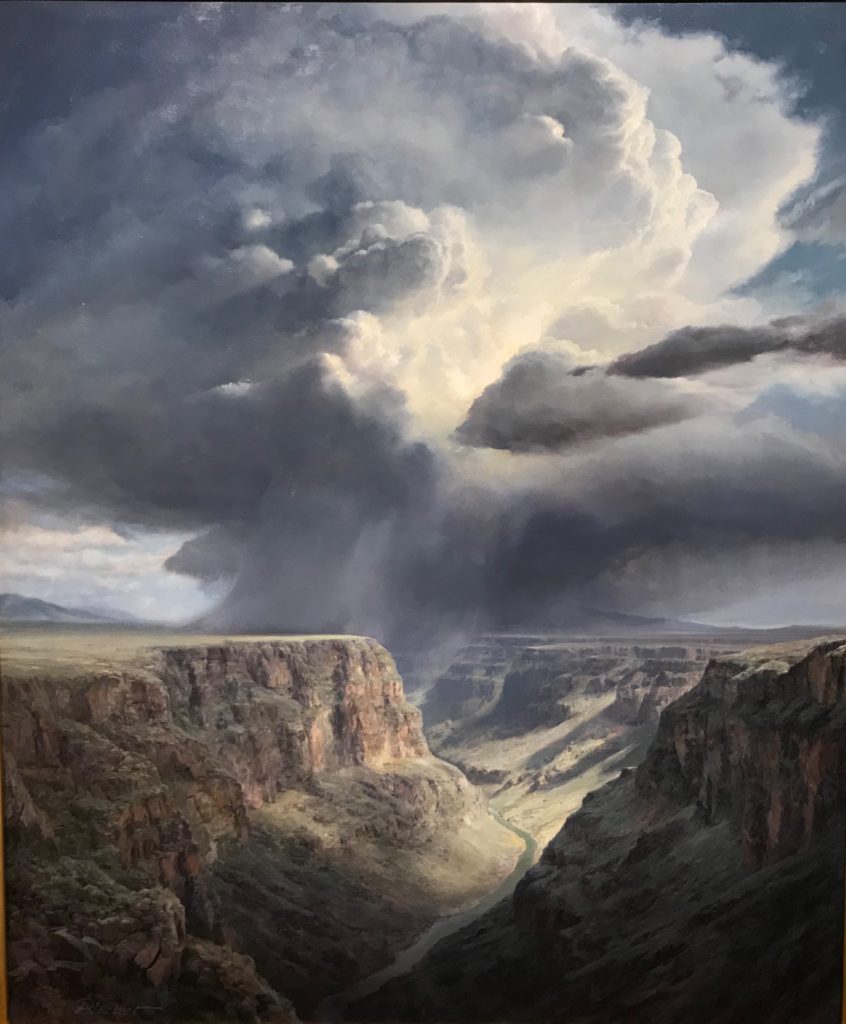
2009
P.A. Nisbet
The Eiteljorg Museum in Indianapolis, Indiana is dedicated “to inspire an appreciation and understanding of the art, history and cultures of the American West and the indigenous peoples of North America”. Like several other distinguished American museums, such as the Gilcrease in Tulsa and the Autry in Los Angeles, the Eiteljorg presents the projection of America’s view of itself, both historical and mythic, as defined by the concept of “West”, most prominently illuminated through its landscapes. The vast open spaces, infinite sky and prismatic light lend themselves to constant reimaginations by contemporary talented artists who seek to evoke the majestic character of the physical world, and capture the “West” of the American mystique. This year, as an extension of its annual Quest of the West show, an exhibition of a consensus collection of the life work of P.A. Nisbet, 2016’s Quest Artist of Distinction, ran from September 8th to November 19th. I had the privilege of loaning one of the works for the show and seeing the exhibition in person. I have collected Nisbet paintings for twenty years, but to see the cumulative vision in one time and one place, made the sense of awe as fresh for me as the very first time.
The exhibition was titled “Light, Space and Power : the Art of P.A. Nisbet”. A curator for the Eiteljorg, Johanna Blume, framed the three components in Nisbet’s work as adding “a spiritual dimension. Light and Space work together to elevate landscapes to preternatural level. They reflect Nisbet’s own sense that the natural world is symbolic of an unknowable, sublime power.” My own familiarity to the artist’s work, and upon visualizing the accumulated works as a whole, lead me to add a fourth dimension , Time, that for me underlies the unique conceptualization of this most talented landscape painter. The recognition of Time, both the instantaneous and the inexorable, is ultimately the most human of characteristics applied by the greatest of landscape painters, for it is only through the projection of a human eye that the wistful recognition that what has just been experienced will never again be seen in the same way and with the same emotions. The artist himself recognizes this dominant dimension. The canyons, deserts, oceans and mountains that seem never changing, are, in the distance of time, ever changing. This human recognition brings an aching sentimentality to the most vast and impersonal of landscapes. An oblique critism of the art, that the human activity is rarely a component of any of the paintings except as a forlorn and indistinct figurine, belies the intensely human perspectives of these landscapes that indicate instead a critical humanity in the form of the viewer, who relays the etherial projection and emotions that can only be recorded in the solitary, by human eyes.
This understanding of time makes Nisbet, as evidenced in the exhibition, one the greatest American painters of unique visions of clouds and waves. Recognizing the time element of the everchanging interplay of wind and light on most elemental of landscape subjects, Nisbet’s clouds are in particular a tour de force in the projection of these familiar landscape components, and as such, have the power to carry an entire painting on their own. Each cloud, each wave, like a snowflake, starts with identical physics, only to mutate over time into a unique and never repeatable vision. In the above Light Storm , Taos, massive forces push simultaneously up and down like magnetic pilings, with brightly illuminated billowing cloudlets seeking the infinite sky and ominously dark pillars of water driving downward and eroding the immutable walls of the canyon. Taos Gorge has been painted time and again, but the perfect actionable verticality of the painting brings the
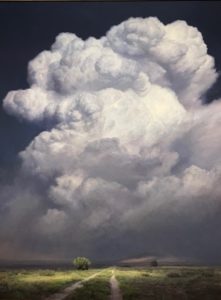
recognition that this immense power display was observed through human eyes, that recognized the etherial nature of the display and its brief existence in time.
Similar geometric tension exists in Collosus, where a road projects into a distant avenger that dares the viewer to risk the journey into a future of malaign portent, or reverse course and stay admidst sunlight.
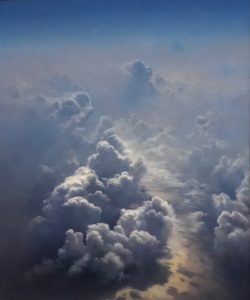
In Elysian Fields, the power is muted as the human perspective is changed to a serene overviewer , and the once massive structures are now a benign, budding coral reef in a luminescent ocean of air.
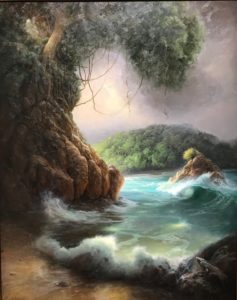
The time element and human perspective is alive in the many visionary interpretations of water. In an early Nisbet creation, Tico’s Paradise, a fantastical. effulgent crashing wave meets a fecund landscape that speaks to Eden and the world prior to the fall of man. A more intense projection of water in Lava Falls brings a vitality and brilliance to moving water and light, with a characteristic Nisbet light motiff of streaming sunlight projecting through the wave crest. You can literally feel the wave mist striking the viewer’s face, with eyes squinting from the triad of gleaming sun, rushing water, and the immense joy felt of being in such a glorious space.
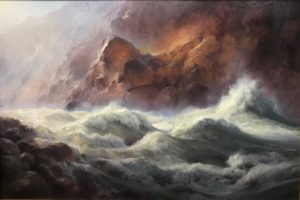
The Southern Sea goes full Turner with brilliantly executed shafts of light from a pewter and bronze sky that blast through the turgurous foam of massive wave caps, blown mist surging against the light with violent fury. Walls of deep blue, grey waves leave the viewer helpless against the scope of the dangerous seas. The artist lets you know he has seen such fury up close in very human terms, as only a human would attempt to exist at the junction of the typhoon above and the watery depths below. Not a bad metaphor for the often tumultous journey of human life itself.
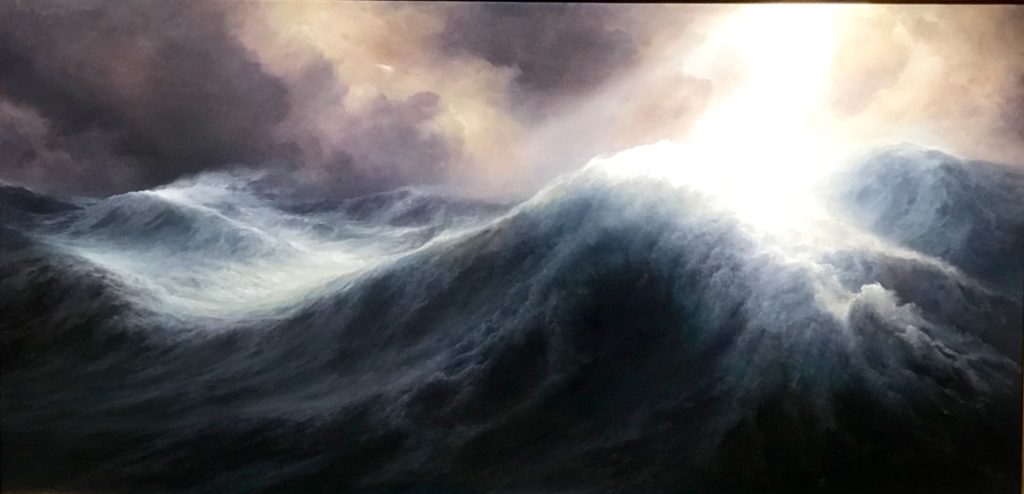
The Grand Canyon is one of Nisbet primal painting joys where, for him, the neverchanging meets the everchanging like no where else on earth. Eons of stone carved by river and rain provide the greatest canvas for light mystique of any structure on earth. Nisbet is in an elite league of Grand Canyon painters that show their understanding of plein air vision on the many vistas of the canyon that all are familiar with, but Nisbet secures light effects that create epic drama
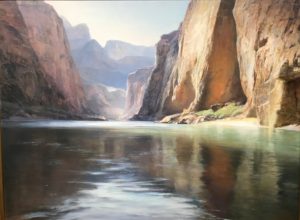
2010
that only someone who has personal, intimate absorption over a life time can imbue. Morning on the Colorado is such a painting, with the mirror like shimmering river lying in the shadow of the canyon wall, projecting against the brilliant sun bleaching out the geologic colors and the layering shadows. Nisbet takes such conceptualization to its logical extreme in two non-exhibition Canyon paintings that are personal favorites of mine added for the discussion. Golden Temple and Breaking Storm , Grand Canyon present dramatic polar opposites of the time effects on light illuminating the never changing canyon geometry with vastly different light – the first, the flat light of the end of day creating almost impressionist light and shadow, the other a single beam of illumination tearing through the dense darkness of a massive storm to bring forward epic drama in minimalist color. Both in my mind are the mark of a master artist.
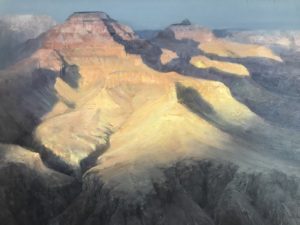
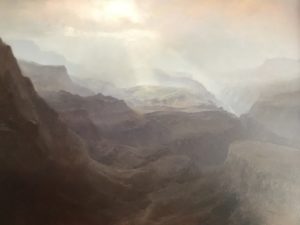
The recognition by the art world of both the unique contribution of an artist along with the understanding of how they fit in the lexicon of great generational painters is one of the higher forms of adulation. P.A. Nisbet is from a lineage of devotion to landscape and seascape painting that recalls Moran and Turner but does not copy them. He is a bit of a throwback to the craft of careful observation of nature, elevating his paintings beyond the often photographic familiarity of modern contempary landscapes or impressionist knockoffs. This is one serious student of his craft, who pushes himself to greater and greater personal clarity no matter what the subject of his works.
In ten thousand years, the ever changing light will be different, the never changing majestic canyons shifted and eroded, the seashores re-ordered, and the climate unknowable. But if humans were to survive the ten thousand years forward like they survived the ten thousand years that brought us to today, they would recognize the deeply profound cords of awe for our world and our place in it, that PA Nisbet has made a career of projecting through his work. And how lucky for us, so much more to come.
Fantastic homage to this great master of our day! Thank you!